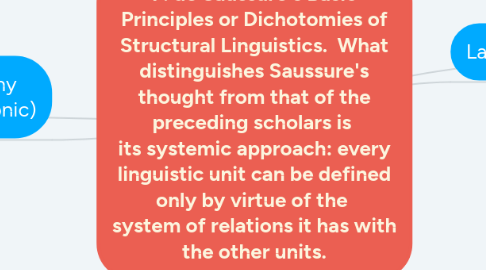F. de Saussure's Basic Principles or Dichotomies of Structural Linguistics. What distinguishes Saussure's thought from that of the preceding scholars is its systemic approach: every linguistic unit can be defined only by virtue of the system of relations it has with the other units.
par Lis Ahumada


1. Synchronic refers to the static side of the study of language on a specific point in time. Diachronic refers to the evolution of language in time, it consider the changes it underwent through time,concerning its historic development. Saussure's opposition between synchrony and diachrony can be condensed (as is standard) in the following way: synchronic facts are systematic and meaningful; diachronic facts are isolated and ateleological (i.e. without a goal).
1.1. When people had more opportunities to change their social class in the 1600s, they started using the words "thee" and "thou" less often. If they didn't know the social class of the person they were addressing, they'd use the formal pronoun "you" to be safely polite, leading to the demise of "thee" and "thou" in English. This would be a diachronic study.
1.2. A description of the words (thee and thou) and how they were used at the time in comparison to the pronoun "you" would be a synchronic description. Studies of "dead" languages can be synchronic, as by definition they are no longer spoken (no native or fluent speakers) nor evolving and are frozen in time.
2. Synchrony & Diachrony (synchronic & diachronic)
3. Arbitrariness of the Sign (signifier & signified)
3.1. Signifier vs. Signified. Saussure believed that signs are better understood on the basis of what signified is (a mental image or concept ) and what signifier is ( a sound or an acoustic image, something that can be touched, seen, heard, etc).
3.1.1. For example an APPLE, this is a sign (object or thing), the SIGNIFIER is the physical existence (sound, word, image) A RED ROUND APPLE; while SIGNIFIED is the mental concept that we have about this sign, for example that is a healthy fruit, could be a Teacher's present, the brand of modern technology.
